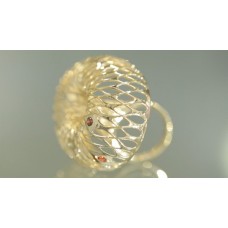Good scope of 3D printing in jewelry industry
According to a new 150-page report from SmarTech Publishing, the market for 3D printers, materials, software and services used by the jewelry industry will exceed $900 million by 2026. This report, “3D Printing Opportunities in the Jewelry Industry – 2017: An Opportunity Analysis and Ten-Year Forecast” is based on SmarTech Publishing’s ongoing coverage of both polymer and metal 3D printing in the jewelry sector.
3D printing finds is finding its way into just about every aspect of jewelry manufacturing, due to the widespread adoption of CAD software among jewelry designers. Annual revenues from 3D-printed hardware, materials, services and software used in the jewelry industry is expected to top $900 Million in 2026.
According to the report, the three largest printing equipment suppliers to the jewelry industry – Stratasys, 3D Systems and EnvisionTEC – hold 73% of the market (per units sold) in 2016. These companies continue to expand their range of hardware and materials engineered to specifically to meet the stringent quality and high productivity requirements for mass jewelry manufacturing.
Increasing adoption of castable photopolymer resins is expected to drive the bulk of the business for 3D printing in jewelry for the near to mid-term future. Demand for photopolymer resins (including wax for material jetting and non-castable prototyping materials) is expected to reach to account for 968,000 Kgs of jewelry oriented materials consumption for AM processes as of 2022. These data reflect the steady growth in the use of photopolymer resins for direct casting in production.
The jewelry industry has been increasing its reliance on the use of 3D printed patterns for direct casting as new trends such as fast fashion and mass customization require smaller batch orders (in the order of hundreds rather than thousands) with faster production requirements and shorter delivery deadlines.
Nevertheless most jewelry manufacturers still use 3D printing only for prototyping or for production of the initial pattern to produce vulcanized silicon molds, which are used to traditionally produce the patterns for lost wax casting.
This lengthy and manual labor intensive process is gradually being replaced through implementation of 3D printers both within jewelry manufacturers and external, jewelry-specific manufacturing services, driving yearly sales of professional photopolymer based 3D printers to reach 2,266 units by 2022, of which 70% are expected to be vat photo polymerization based systems.
A niche yet potentially very significant opportunity will come from the precious metal powder-based AM technology sector, with focus gold and platinum powder-bed fusion systems. Gold is significant as it remains by far the most commonly used precious material in jewelry and in directly 3D printed jewelry as well, accounting for over 86% of all precious metal AM powders in 2022.
New technologies are also expected to introduce the possibility of offering new gold alloys and gold colors (such as green and blue) that are difficult to work with standard manufacturing processes. Platinum alloys also stand to significantly benefit from 3D printing technologies, by enabling thing and lightweight platinum jewelry products that are impossible to manufacture by traditional means.
Even in traditional jewelry manufacturing with vulcanized silicon molds, the initial model is often 3D printed using high-temperature resistant photopolymer resins. Jewelry prototyping for size and shape verification is complemented by the use of directly 3D printed wax and resin patterns for direct casting and serial manufacturing. The next evolutionary step is direct metal 3D printing.




